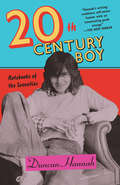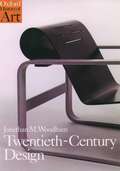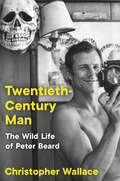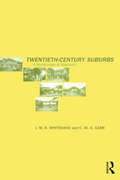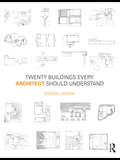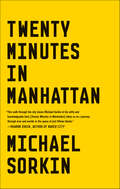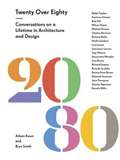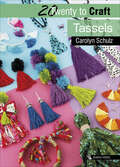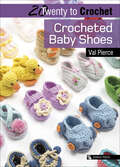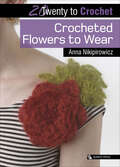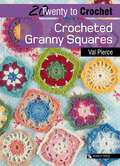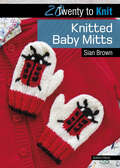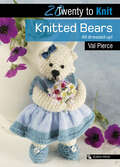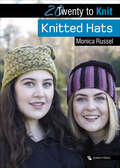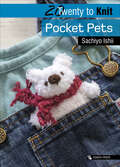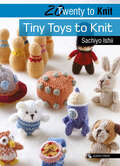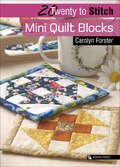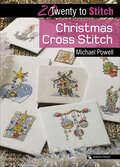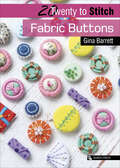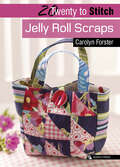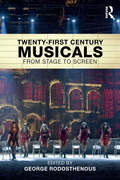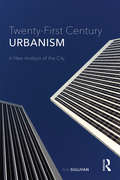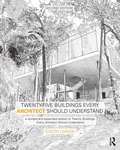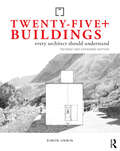- Table View
- List View
Twentieth-Century Boy: Notebooks of the Seventies
by Duncan HannahA celebrated New York City painter's rollicking and vividly immediate account of his life amid the city's glamorous demimondes in their most vital era as an aspiring artist, roaring boy, dandy, cultural omnivore, and far-from-obscure object of desire. Duncan Hannah arrived in New York City from Minneapolis in the early 1970s as an art student hungry for experience, game for almost anything, and with a prodigious taste for drugs, girls, alcohol, movies, rock and roll, books, parties, and everything else the city had to offer. He also happened to be outrageously, androgynously beautiful, attracting the attention of the city's most prominent gay scenemeisters, who found his adamant heterosexuality a source of immense frustration. Taken directly from the notebooks Hannah kept throughout the seventies, Twentieth-Century Boy is a louche, sometimes lurid, and incredibly entertaining report from a now almost mythical time and place, full of outrageously bad behavior, naked ambition, gender-bending celebrities, fantastically good music and evaporating barriers of taste and decorum. At its center: a young man in the mix and on the make, determined to forge an identity for himself as an artist while being at risk from his own heedless appetites. A time capsule from a scary, seedy, but irresistible time and place.
Twentieth-Century Design (Oxford History of Art Ser.)
by Jonathan M. WoodhamThe most famous designs of the twentieth century are not those in museums, but in the marketplace. The Coca-Cola bottle and the MacDonald's logo are known all over the world, and designs like the modernistic 'Frankfurt Kitchen' of 1926, or the 1954 streamlined and tail-finned Oldsmobile, or'Blow', the inflatable chair ubiquitous in the late sixties, tell us more about our culture than a narrowly-defined canon of classics. Drawing on the most up-to-date scholarship (not only in design history but also in social anthropology and women's history), Jonathan Woodham takes a fresh look at the wider issues of design and industrial culture throughout Europe, Scandinavia, North America, and the Far East. He explores themessuch as national identity, the 'Americanisation' of ideology and business methods, the rise of the multi-nationals, Pop and Postmodernism, and contemporary ideas of nostalgia and heritage, and sets the proliferation of everyday design against the writing of critics as different as Nikolaus Pevsner,the champion of Modernism, and Vance Packard, author of The Hidden Persuaders. In the history which emerges design is clearly seen for what it is: the powerful and complex expression of aesthetic, social, economic, political, and technological forces.
Twentieth-Century Man: The Wild Life of Peter Beard
by Christopher WallaceAn exuberant biography of the life of the iconic photographer and naturalist Peter Beard, whose life and work captured the cultural imagination Peter Beard lived an astonishing life. The artist, wildlife photographer, and bon vivant enthralled and inspired both because of his work and his legendary lifestyle. A scion of American industry turned explorer of Africa and environmental advocate, Beard embodied the extremes of his time: grand adventurer and sexually voracious partier, friend of everyone from the Rolling Stones to Jackie Onassis to Andy Warhol to Karen Blixen. And Beard had a passion—probably more like an obsession—with the faults of the entire human experiment, with the ways in which our consumption of the world’s resources have come to consume us all. Beard’s outsize life and character—his death-defying documentation of both the endangered wildlife of Africa, and, closer to home, some of the world’s most beautiful women for a range of fashion magazines—animate this lively but authoritative biography. The journalist Christopher Wallace, long fascinated by Beard’s artistic legacy, adventurous spirit, and hard-partying persona, came to know him well later in Beard’s life. Capturing the varied social and cultural scenes that Beard moved through with glamorous ease over five decades, Wallace also makes a powerful case for the lasting impact of his work. In Twentieth-Century Man, Wallace has rendered this towering figure in all of his contradictions and complexities—a deeply romantic and idiosyncratic personality, beloved by so many, whose sensibilities nonetheless remained firmly rooted in an era characterized by racist and colonialist attitudes. Stirring and visceral, Twentieth-Century Man is the definitive portrait of Peter Beard.
Twentieth-Century Suburbs: A Morphological Approach (Planning, History and Environment Series #Vol. 1)
by C.M.H Carr J.W.R WhitehandGarden suburbs were the almost universal form of urban growth in the English-speaking world for most of the twentieth century. Their introduction was probably the most fundamental process of transformation in the physical form of the Western city since the Middle Ages.This book describes the ways in which these suburbs were created, particularly by private enterprise in England in the 1920s and 1930s, the physical forms they took, and how they have changed over time in response to social, economic and cultural change.Twentieth-Century Suburbs is concerned with the history, geography, architecture and planning of the ordinary suburban areas in which most British people live. It discusses the origins of suburbs; the ways in which they have been represented; the scale and causes of their growth; their form and architectural style; the landowners, builders and architects responsible for their creation; the changes they have undergone both physically and socially; and their impact on urban form and the implications for urban landscape management.
Twenty Buildings Every Architect Should Understand: A Revised And Expanded Edition Of Twenty Buildings Every Architect Should Understand
by Simon UnwinHave you ever wondered how the ideas behind the world's greatest architectural designs came about? What process does an architect go through to design buildings which become world-renowned for their excellence? This book reveals the secrets behind these buildings. He asks you to 'read' the building and understand its starting point by analyzing its final form. Through the gradual revelations made by an understanding of the thinking behind the form, you learn a unique methodology which can be used every time you look at any building.
Twenty Minutes in Manhattan
by Michael SorkinEvery morning, the architect and writer Michael Sorkin walks downtown from his Greenwich Village apartment through Washington Square to his Tribeca office. Sorkin isn't in a hurry, and he never ignores his surroundings. Instead, he pays careful, close attention. And in TwentyMinutes in Manhattan, he explains what he sees, what he imagines, what he knows—giving us extraordinary access to the layers of history, the feats of engineering and artistry, and the intense social drama that take place along a simple twenty-minute walk.
Twenty Names in Art (Twenty Names)
by Alan BlackwoodA collection of brief biographies of twenty famous artists. Explores art from earliest times to the present and artists who have provided the greatest influence on art history or art styles. Inside you will learn about: Hieronymous Bosch, Leonardo da Vinci, Albrecht Durer, Michelangelo, El Greco, Rembrandt, William Hogarth, Hokusai, J. M. W. Turner, Claude Monet, Berthe Morisot, Vincent Van Gogh, Henry Ossawa, Rabindranath Tagore, Kathe Kollwitz, Pablo Picasso, Henry Moore, Salvadore Dali, Sydney Nolan, and Andy Warhol.
Twenty Over Eighty: Conversations on a Lifetime in Architecture and Design
by Aileen Kwun Bryn SmithTwenty Over Eighty is a collection of insightful, intimate, and often irreverent interviews with twenty architecture and design luminaries over the age of eighty. Revealing conversations with leaders from a variety of fields--including graphic designers Seymour Chwast, Milton Glaser, Lora Lamm, and Deborah Sussman; architects Michael Graves, Denise Scott Brown, and Stanley Tigerman; urbanist Jane Thompson; industrial designer Charles Harrison; furniture designer Jens Risom; and critic Ralph Caplan--spotlight creators, thinkers, and pioneers whose lifelong dedication to experimentation and innovation continues to shape their disciplines well into their ninth decade.Twenty Over Eighty is not only a record of the remarkable histories and experiences of design's most influential figures but also a source of knowledge and inspiration for contemporary creatives and generations to come.
Twenty to Craft: Tassels (Twenty to Make)
by Carolyn SchulzTassels are fashionable, fun and easy to make! The 20 projects in this book include a wonderful variety of tassels, made using a range of easy techniques and a few inexpensive materials. Carolyn Schulz has put her jewellery-making expertise to good use to create gorgeous bag charms, decorative key fobs and fashionable jewellery. There are folk-inspired tassels created using colourful threads and frayed fabric strips, leather tassels and small, simple tassels combined with beads and ribbon used to make colourful earrings and brooches. The basic tassel-making technique couldn't be easier and is explained at the beginning of the book, and all the projects have easy-to-follow step-by-step instructions. No previous crafting experience is necessary. The materials used are widely available, and most can be sourced from scraps and left-over fabric, yarn and threads.
Twenty to Crochet: Crocheted Baby Shoes (Twenty to Make)
by Val PierceLearn to crochet 20 different, adorable pairs of baby shoes quickly and easily.Looking for a unique baby gift? Here are twenty gorgeous shoes, booties, and pumps to crochet in a range of colors and styles, for both boys and girls. Choose from red strawberry-style shoes with flowery toes, smiley car shoes, Christmas booties, and even shoes shaped like frogs! Each pair of shoes requires relatively small quantities of yarn and can be crocheted quickly, easily, and on the go using the clear instructions provided. Each project is accompanied by lists of the materials and equipment required and inspiring photographs. As all babies are different, sizes and age suggestions are given for each project, from birth to twelve months, but general advice is also given at the beginning of the book on how to increase or decrease the size of the projects.
Twenty to Crochet: Crocheted Flowers to Wear (Twenty to Make)
by Anna NikipirowiczThis lovely book provides 20 contemporary, stylish designs for crocheted corsages – large, eye-catching floral designs that can be worn in different ways: as a brooch, buttonhole, on your wrist, shoes, bag or belt, for example. The flowers are made in a variety of sizes and styles, with different types of flower, all worked in various colours, yarns and crochet stitches. Some feature added embellishments such as buttons and beads. Some of the flowers are based on real ones, such as the pansy, lily and hydrangea, while others, such as spectrum, roux and rainbow are fantasy flowers designed by Anna. There is more variety in that some of the flowers are quite flat, while others are distinctly 3-D, giving them added appeal. The patterns are easy to follow and there is a beautiful photograph of each one, suggesting ways of wearing them. All of the materials used are widely available both here and in the US. Examples of the author's work can be found on her website, www.moochka.co.uk.
Twenty to Crochet: Crocheted Granny Squares (Twenty to Make)
by Val Pierce“With twenty granny squares of flower patterns, hexagons, circles and triangles you can make eight different crochet projects . . . A great stashbuster.” —Examiner.comWant to learn how to crochet? Make a granny square! The simple techniques have lasted for decades and now they are trendier than ever. With endless colour and size variations, creating these squares is fun and easy. They can be used like building blocks and combined with other squares to make original projects and gifts or used to embellish larger items.This book will show you how to create twenty different squares, including flower patterns, interpreted in different colours and yarns to create a kaleidoscope of effects. Also included are projects that show you how to make the squares into a simple baby blanket, arm warmers, a purse, a pin cushion, a mug cosy and a stylish pair of boot toppers. DMC yarns as well as fancy yarns are used, all of which are readily available, and both US and UK crochet abbreviations are used throughout. Granny squares are an ideal way to learn how to crochet, so this book is perfect for beginners.“The venerable granny square is updated, refreshed and explored in this exuberant collection . . . The virtues of this pretty little book are its portability and engaging images of attractive motifs.” —Crochet Savvy
Twenty to Knit: Knitted Baby Mitts (Twenty to Make)
by Sian BrownKnit adorable pairs of tiny mittens for the new baby in your life with this easy-to-use guide featuring twenty irresistible designs.Knitwear designer Sian Brown shares twenty patterns in a range of colours and styles for boys and girls, from traditional stripes and cables to whimsical rabbits, frogs and ladybirds. Each design can be knitted in three different sizes suitable for 0-3, 3-6 and 6-12 month-old babies, with the option of including thumbs in the largest size. The patterns use small amounts of either baby- or fingering-weight yarn, and knit up quickly and easily using the clear, step-by-step instructions and full-colour charts. Each project comes with a list of the yarns and needles required and a full-colour photograph of the finished mittens, providing everything you need to create these gorgeous handmade gifts for babies.
Twenty to Knit: Knitted Bears All Dressed Up! (Twenty to Make)
by Val PierceDiscover how to knit 20 cuddly new friends with these fun projects.All the bears in the book are based on the same, simple knitted bear, instructions for which are provided at the beginning of the book and are easy enough for even novice knitters to follow. There are 20 unique designs, including a hiking bear complete with boots and a backpack, a beach-loving bikini bear, a sweet honeybee bear, and a pretty pink ballet dancer, each with its own knitted outfit and accessories. Every bear has its own special character, and the reader is bound to find at least one they just have to knit. Suitable for adults as well as children, they make ideal gifts, and of course there is nothing to stop the reader creating characters of their own that they can personalize to suit a particular person or occasion.
Twenty to Knit: Knitted Hats (Twenty to Make)
by Monica RusselKnitted hats are never out of fashion, and in this collection of twenty hats to knit, Monica Russel brings you traditional, and modern, designs that you will want to wear all year round! From the beanie to the beret, each design can be knitted as shown in the book, using the easy-to-follow instructions, or adapted in a colour scheme that best suits the wearer. Choose from bobble hats or Nordic ski hats complete with ear-flaps and tassels, plain weaves or Fair Isle knits: the twenty designs can be adapted into a multitude of colour and pattern combinations – there’s a knitted hat to be made for every discerning head!
Twenty to Knit: Pocket Pets (Twenty to Make)
by Sachiyo IshiiMake your own collection of irresistibly cute knitted animals in soft, fleecy yarn. This gorgeous knitting book for knitters of all abilities by Sachiyo Ishii contains 20 lovely projects including a baby penguin, a koala bear, a guinea pig and a squirrel. All the projects are accompanied by clear, easy-to-follow patterns and photography. There is a useful page of basic techniques at the start of the book, including making up, stuffing, and simple, decorative surface stitching. These lovely mini knits are all bursting with character and feel extra soft and snuggly. All the projects are exquisitely designed and very easy to make. They make perfect gifts and will delight young and old alike.
Twenty to Knit: Tiny Toys to Knit (Twenty to Make)
by Sachiyo IshiiLearn to make quick, easy, and adorable pocket pets in soft, fleecy yarn with this guide featuring twenty patterns for knit toys.In this guide for knitters of all abilities, Sachiyo Ishii shares twenty original projects including a baby penguin, a koala bear, a guinea pig and a squirrel. Exquisitely designed and easy to make, these fleecy creatures make perfect gifts to delight young and old alike.All the projects are accompanied by clear instructions and detailed photography. Ishii also includes a handy overview of basic techniques, including making up, stuffing and decorative surface stitching.
Twenty to Stitch: A Practical Guide To Sewing And Hand Quilting 20 Stunning Projects (Twenty to Make)
by Carolyn ForsterDiscover how to create one of these 20 mini quilt blocks to adapt to small patchwork projects.Ideal for patchworkers, quilters, and sewists looking for ideas and inspiration, this book contains designs for 20 mini blocks, all measuring just 12.5cm (5 inches) square, and all constructed from basic shapes including squares, triangles, and rectangles. Mini quilt blocks are ideal for making small patchwork projects such as bags, pincushions, coasters, and placemats, for incorporating into larger blocks, or for forming motifs within a larger quilt design.Each of the 20 projects are shown four ways, to inspire the reader with different fabrics and colorways. Each project is accompanied by the number and size of each shape in the block and instructions on the order in which to put the shapes together. Includes techniques on how to cut the shapes using a rotary cutter and ruler, design ideas, and instructions for a simple coaster.
Twenty to Stitch: Christmas Cross Stitch (Twenty to Make)
by Michael PowellCreate twenty unique and whimsical Christmas cross-stitch designs with this latest addition to the Twenty to Make series. Emulate Michael Powell’s distinctive cross-stitch style to make Christmas cards or samplers as special gifts for friends and family. Designs range from festive candle arrangements to vintage winter street scenes, and each design is accompanied by an easy-to-follow stitching guide.
Twenty to Stitch: Fabric Buttons (Twenty to Make)
by Gina BarrettLearn to make 20 button designs using fabric – as an embellishment to a garment or as a piece of jewellery or accessory. Gina Barrett uses techniques such as stitching, embroidery and beading, and provides shaped templates for those projects where the reader may need more assistance. The buttons are all worked at a small size, so will require limited materials and thread for a polished finish. There are no complex button-making techniques here; all the buttons can be created by the reader at home, following Gina's straightforward instructions and stitch diagrams.
Twenty to Stitch: Jelly Roll Scraps (Twenty to Make)
by Carolyn ForsterTwenty quick and easy sewing projects using left-over scraps of fabric from your Jelly Rolls. Quilters and patchworkers all over the world are familiar with Jelly Rolls - bundles of coordinating fabrics manufactured by Moda, pre-cut into useful 2½in (6.5cm) strips. But what do you do with all those left-over pieces once you&’ve made your patchwork quilt? Instead of assigning them to the waste bin, save them up and you will soon have enough to stitch at least one of the fun projects in this book. Using simple sewing, quilting, and patchwork techniques, there are twenty projects to choose from, including stylish cushions, pretty little bags and a handy pincushion, all of which are quick and easy to make. If you don&’t use Jelly Rolls, any odd scraps of fabric can be used instead—just cut them to size and away you go! All the templates are provided as well as some basic tips and techniques, and each project is accompanied by a list of the materials and tools you need, as well as clear, step-by-step instructions.
Twenty-First Century Musicals: From Stage to Screen
by George RodosthenousTwenty-First Century Musicals stakes a place for the musical in today’s cinematic landscape, taking a look at leading contemporary shows from their stage origins to their big-screen adaptations. Each chapter offers a new perspective on a single musical, challenging populist narratives and exploring underlying narratives and sub-texts in depth. Themes of national identity; race, class and gender; the ‘voice’ and ‘singing live’ on film; authenticity; camp sensibilities; and the celebration of failure are addressed in a series of questions including: How does the film adaptation provide a different viewing experience from the stage version? What themes are highlighted in the film adaptation? What does the new casting bring to the work? Do camera angles dictate a different reading from the stage version? What is lost/gained in the process of adaptation to film? Re-interpreting the contemporary film musical as a compelling art form, Twenty-First Century Musicals is a must-read for any student or scholar keen to broaden their understanding of musical performance.
Twenty-First Century Urbanism: A New Analysis of the City
by Rob SullivanThis volume argues that the city cannot be captured by any one mode of analysis but instead is composed of the mobile, relational, efficient, sentient, and the phenomenological with all of them cast in new theoretical configurations and combined into one methodological entity. Rather than focusing on any one city or abstract analytical model, this book instead takes a multipronged theoretical and methodological approach to present the city as an intelligent affective organism – a sentient being. It proposes that cities operate on a relational, mobile, and phenomenological basis through the mode of efficiency, calibrated by a profoundly complicated division of labor. Its starting point is that the city is a mobile unit of analysis, from its economic status to its demographic makeup, from its cultural configuration to its environmental conditions, and therefore easily evades our quantitative and qualitative methods of computation and comprehension. Twenty-First Century Urbanism provides planning and urban design academics and students with a multifaceted approach to understanding the development of cities, encouraging the examination of cities through a myriad, non-linear approach.
Twenty-Five Buildings Every Architect Should Understand: a revised and expanded edition of Twenty Buildings Every Architect Should Understand
by Simon UnwinTwenty-Five Buildings Every Architect Should Understand is an essential companion to Simon Unwin's Analysing Architecture, and part of the trilogy which also includes his Exercises in Architecture: Learning to Think as an Architect. Together the three books offer an introduction to the workings of architecture providing for the three aspects of learning: theory, examples and practice. Twenty-Five Buildings focusses on analysing examples using the methodology offered by Analysing Architecture, which operates primarily through the medium of drawing. In this second edition five further buildings have been added to the original twenty from an even wider geographical area, which now includes the USA, France, Italy, Mexico, Switzerland, Spain, Finland, Germany, Australia, Norway, Sweden, India and Japan. The underlying theme of Twenty-Five Buildings Every Architect Should Understand is the relationship of architecture to the human being, how it frames our lives and orchestrates our experiences; how it can help us make sense of the world and contribute to our senses of identity and place. Exploring these dimensions through a wide range of case studies that illustrate the rich diversity of twentieth and twenty-first century architecture, this book is essential reading for every architect.
Twenty-Five+ Buildings Every Architect Should Understand: Revised and Extended Edition
by Simon UnwinThe underlying theme of Twenty-Five+ Buildings Every Architect Should Understand is the relationship of architecture to the human being, how it frames our lives and orchestrates our experience; how it can help us make sense of the world and contribute to our sense of identity and place. Exploring these dimensions through a wide range of case studies that illustrate the rich diversity of twentieth- and twenty-first-century architecture, this book is essential reading for every architect. With the addition of numerous shorter analyses, this new edition covers an even greater range of architectural ideas, providing students and architects with further inspiration for exploration in their own design work. Architects live by ideas. But where do they come from? And how do they shape buildings? There is no one right way to do architecture. This book illustrates many. Its aim is to explore the rich diversity of architectural creativity by analysing a wide range of examples to extract the ideas behind them. Twenty-Five+ Buildings Every Architect Should Understand is a companion to Simon Unwin’s Analysing Architecture: the Universal Language of Place- Making (most recent edition, 2021), and part of the trilogy which also includes his Exercises in Architecture: Learning to Think as an Architect (second edition, 2022). Together the three books offer an introduction to the workings of architecture providing for the three aspects of learning: theory, examples and practice. Twenty-Five+ Buildings focusses on analysing examples using the methodology offered by Analysing Architecture, which operates primarily through the medium of drawing. An underlying theme of Twenty-Five+ Buildings Every Architect Should Understand is the relationship of architecture to the human being, how it frames our lives and orchestrates our experiences; how it can help us give form to the world and contributes to our senses of identity and place. Exploring these dimensions through case studies that illustrate the rich diversity of twentieth- and twenty-first-century architecture, this book is essential reading, and hopefully an inspiration, for every architect. In this new edition supplementary analysis and discussion has been added to each of the twenty-five case studies, drawing attention to their influences from and on other architects. A number of extra shorter analyses have been included too, following the practice of presenting extra small dishes interspersed among main courses in high-end restaurants. These additional short analyses account for the + sign after ‘Twenty-Five’ in the title of this edition, and double the number of buildings analysed to around fifty.
